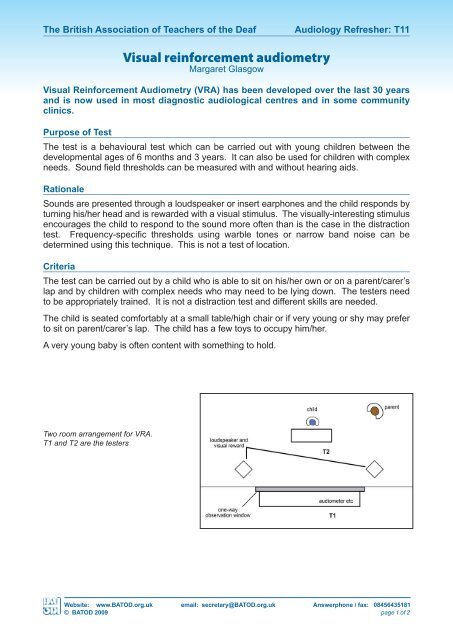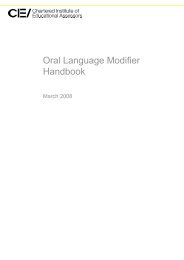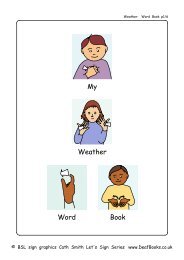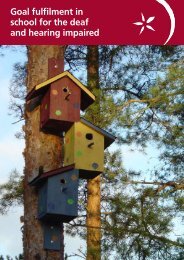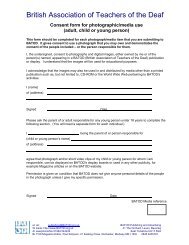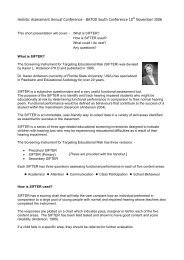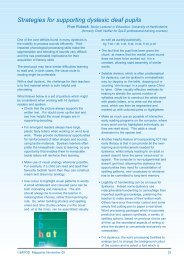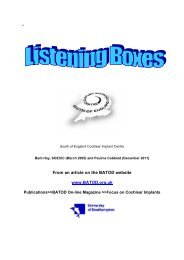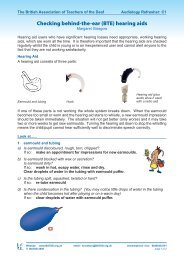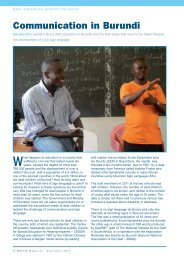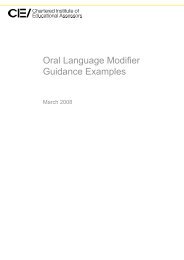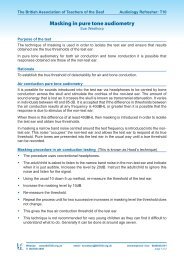Visual reinforcement audiometry - batod
Visual reinforcement audiometry - batod
Visual reinforcement audiometry - batod
Create successful ePaper yourself
Turn your PDF publications into a flip-book with our unique Google optimized e-Paper software.
The British Association of Teachers of the Deaf<br />
Audiology Refresher: T11<br />
<strong>Visual</strong> <strong>reinforcement</strong> <strong>audiometry</strong><br />
Margaret Glasgow<br />
<strong>Visual</strong> Reinforcement Audiometry (VRA) has been developed over the last 30 years<br />
and is now used in most diagnostic audiological centres and in some community<br />
clinics.<br />
Purpose of Test<br />
The test is a behavioural test which can be carried out with young children between the<br />
developmental ages of 6 months and 3 years. It can also be used for children with complex<br />
needs. Sound field thresholds can be measured with and without hearing aids.<br />
Rationale<br />
Sounds are presented through a loudspeaker or insert earphones and the child responds by<br />
turning his/her head and is rewarded with a visual stimulus. The visually-interesting stimulus<br />
encourages the child to respond to the sound more often than is the case in the distraction<br />
test. Frequency-specific thresholds using warble tones or narrow band noise can be<br />
determined using this technique. This is not a test of location.<br />
Criteria<br />
The test can be carried out by a child who is able to sit on his/her own or on a parent/carer’s<br />
lap and by children with complex needs who may need to be lying down. The testers need<br />
to be appropriately trained. It is not a distraction test and different skills are needed.<br />
The child is seated comfortably at a small table/high chair or if very young or shy may prefer<br />
to sit on parent/carer’s lap. The child has a few toys to occupy him/her.<br />
A very young baby is often content with something to hold.<br />
Two room arrangement for VRA.<br />
T1 and T2 are the testers<br />
Website: www.BATOD.org.uk email: secretary@BATOD.org.uk Answerphone / fax: 08456435181<br />
© BATOD 2009 page 1 of 2
The British Association of Teachers of the Deaf<br />
Audiology Refresher: T11<br />
<br />
<br />
<br />
<br />
<br />
<br />
The sound and visual reward (usually a flashing light or a moving puppet) are presented<br />
at the same time and the child is shown where to look for the reward. The sound stimulus<br />
is presented at an intensity level and frequency where it is thought the child may be able<br />
to respond.<br />
This conditioning is repeated until the child is able to anticipate the visual reward and look<br />
as soon as the sound is presented.<br />
When the child is regularly anticipating the reward the sound only is introduced and the<br />
visual reward is given after a definite head turn.<br />
Fairly long gaps in the presentation of sounds are required, otherwise the child will keep<br />
checking and it will be difficult to be sure of the response.<br />
There is no rigid protocol for presenting stimuli. The most useful information is gathered<br />
before the child tires. Minimum responses are recorded at 1khz, 4 khz, and 500 khz to<br />
gain information across the frequency range.<br />
Thresholds below normal limits are not usually investigated.<br />
In the majority of cases two appropriately trained testers are needed:<br />
Tester 1 operates the audiometer and gives the visual reward.<br />
Tester 2 is with the child and helps to manage his/her behaviour. This is a low key activity<br />
which keeps the child facing forward. S/he gives encouragement during conditioning and is<br />
responsible for deciding when /if a different toy needs to be introduced. It is not always<br />
necessary for this tester to manage the child’s attention after conditioning as some children<br />
sit quite happily with a toy and respond to the sounds appropriately. A young child can often<br />
be managed effectively by the parent/carer with instructions from the tester.<br />
It is possible to use only one loudspeaker located at 45, 60 or 90 degrees azimuth.<br />
VRA and Bone Conduction<br />
This behavioural test is also used to gain information about bone conduction thresholds using a conventional<br />
bone conduction vibrator and headband.<br />
VRA with Insert Earphones<br />
Small earphones can be inserted into the ears which enable sound stimuli to be presented at<br />
the tympanic membrane. Thresholds of detectability at specific frequencies can be measured<br />
in each ear. Sounds are normally warble tones or pure tones.<br />
This method enables babies as young as 6 to 7 months to give results that can be plotted as<br />
a bilateral audiogram and is essential for hearing aid fitting and audiological management.<br />
Loudspeakers and visual reward<br />
Website: www.BATOD.org.uk email: secretary@BATOD.org.uk Answerphone / fax: 08456435181<br />
© BATOD 2009 page 2 of 2


